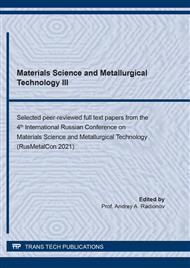[1]
V.B. Ginzburg, Flat-Rolled Steel Processes: Advanced Technologies, CRC Press, (2009).
Google Scholar
[2]
W.L. Roberts, Cold Rolling of Steel, Marcel Dekker, (1978).
Google Scholar
[3]
S.M. Belskiy, Yu.A. Mukhin, Hot strip rolling with local thickening, Steel in Translation. 39(5) (2009) 420-424.
DOI: 10.3103/s0967091209050143
Google Scholar
[4]
S.M. Belskiy, V.A. Pimenov, A.N. Shkarin, Mathematical model for evaluating the actual form of the profile's contour of the hot-rolled strip's cross section, Journal of Chemical Technology and Metallurgy. 56(1) (2020) 214-220.
DOI: 10.17580/chm.2020.12.04
Google Scholar
[5]
S.M. Belskiy, I.I. Shopin, Predictive mathematical model of strip breakage during cold rolling, Chernye Metally. 3 (2020) 18-23.
Google Scholar
[6]
S.M. Bel¢skii, Yu.A. Mukhin, Classification of regulation principles for strip flatness, Steel in Translation. 39(11) (2009) 1012-1015.
DOI: 10.3103/s0967091209110114
Google Scholar
[7]
V.N. Shinkin, Influence of non-linearity of hardening curve on elasticoplastic bend of rectangular rod, CIS Iron and Steel Review. 17 (2019) 39-42.
DOI: 10.17580/cisisr.2019.01.07
Google Scholar
[8]
V.N. Shinkin, Springback coefficient of round steel beam under elastoplastic torsion, CIS Iron and Steel Review. 15 (2018) 23-27.
DOI: 10.17580/cisisr.2018.01.05
Google Scholar
[9]
A.A. Korolev, Mechanical Equipment of Rolling and Pipe Shops, Metallurgy, (1987).
Google Scholar
[10]
I.V. Ushakov, Method of mechanical testing of laser treated metallic glass by indenters with different geometry, Proceedings of SPIE - The International Society for Optical Engineering. 6597 (2007) 659714.
DOI: 10.1117/12.726773
Google Scholar
[11]
M. Predeleanu, P. Gilormini, Advanced Methods in Materials Processing Defects 45, Elsevier Science, (1997).
Google Scholar
[12]
C.E. Wilko, Formability: A Review of Parameters and Processes That Control, Limit or Enhance the Formability of Sheet Metal, Springer, (2011).
Google Scholar
[13]
V.N. Shinkin, Simple analytical dependence of elastic modulus on high temperatures for some steels and alloys, CIS Iron and Steel Review. 15 (2018) 32-38.
DOI: 10.17580/cisisr.2018.01.07
Google Scholar
[14]
V.N. Shinkin, Elastoplastic flexure of round steel beams. 2. Residual stress, Steel in Translation. 48(11) (2018) 718-723.
DOI: 10.3103/s0967091218110098
Google Scholar
[15]
D. Banabic, Multiscale Modeling in Sheet Metal Forming, Springer, (2016).
Google Scholar
[16]
I.V. Ushakov, Yu.V. Simonov, Formation of surface properties of VT18u titanium alloy by laser pulse treatment, Materials Today: Proceedings. 19(5) (2019) 2051-2055.
DOI: 10.1016/j.matpr.2019.07.072
Google Scholar
[17]
P. Hu, N. Ma, L.-Z. Liu, Y.-G. Zhu, Theories, Methods and Numerical Technology of Sheet Metal Cold and Hot Forming: Analysis, Simulation and Engineering Applications, Springer, (2013).
DOI: 10.1007/978-1-4471-4099-3
Google Scholar
[18]
V.L. Mazur, Production of cold-rolled steel coils, Steel in Translation. 41(9) (2011) 756-760.
DOI: 10.3103/s0967091211090154
Google Scholar
[19]
V.N. Shinkin, Elastoplastic flexure of round steel beams. 1. Springback coefficient, Steel in Translation. 48(3) (2018) 149-153.
DOI: 10.3103/s0967091218030117
Google Scholar
[20]
V.N. Shinkin, Preliminary straightening of steel strip, Chernye Metally. 5 (2018) 34-40.
Google Scholar
[21]
S.M. Belskiy, V.A. Pimenov, A.N. Shkarin, Assessment of the actual shape of the hot-rolled strip cross-section contour. Part 1. Geometric parameters, Chernye Metally. 8 (2020) 25-28.
DOI: 10.17580/chm.2020.12.04
Google Scholar
[22]
S.M. Belskiy, A.N. Shkarin, V.A. Pimenov, Assessment of the actual shape of the hot-rolled strip cross-section contour. Part 2. Profile classifier, Chernye Metally. 12 (2020) 33-37.
DOI: 10.17580/chm.2020.12.04
Google Scholar
[23]
V.N. Shinkin, Direct and inverse non-linear approximation of hardening zone of steel, Chernye Metally. 3 (2019) 32-37.
Google Scholar
[24]
V.N. Shinkin, Approximate calculation method of subwater pipeline's form under its laying on sea-bottom, CIS Iron and Steel Review. 18 (2019) 42-45.
DOI: 10.17580/cisisr.2019.02.09
Google Scholar
[25]
M.V. Khlopotin, Investigation of the Thermal Regime of Rolls of Broadband Hot Rolling Mills and Its Effect on the Transverse Profile of Hot Rolled Strips, Cherepovets, (2010).
Google Scholar
[26]
A.N. Shkarin, S.M. Bel¢skii, V.A. Pimenov, Influence of the cross-sectional shape of hot semifinished rolled products on the formation of the plot of specific tension in cold-rolled strips, Metallurgist. 64(7-8) (2020) 699-708.
DOI: 10.1007/s11015-020-01046-0
Google Scholar
[27]
S.M. Belskiy, I.I. Shopin, A.N. Shkarin, On adequacy of parameters of strip's cross-section profile. Message 1. Predictive interval, Chernye Metally. 3 (2020) 18-23.
Google Scholar
[28]
I.V. Ushakov, V.A. Feodorov, I.J. Permyakova, Mechanical characteristics and crystallization of annealed metallic glass 82K3XCP, Proceedings of SPIE - The International Society for Optical Engineering. 5400 (2004) 261-264.
DOI: 10.1117/12.555528
Google Scholar
[29]
I.V. Ushakov, How a crack and the defect material in its neighborhood affect the radiation strength of transparent materials, Journal of Optical Technology. 75(2) (2008) 128-131.
DOI: 10.1364/jot.75.000128
Google Scholar
[30]
V.A. Pimenov, V.S. Pertseva, Development of methods for analysis and assessment of the accuracy of the transverse profile of hot-rolled steel, Metallurgist. 9 (2014) 66-70.
Google Scholar


